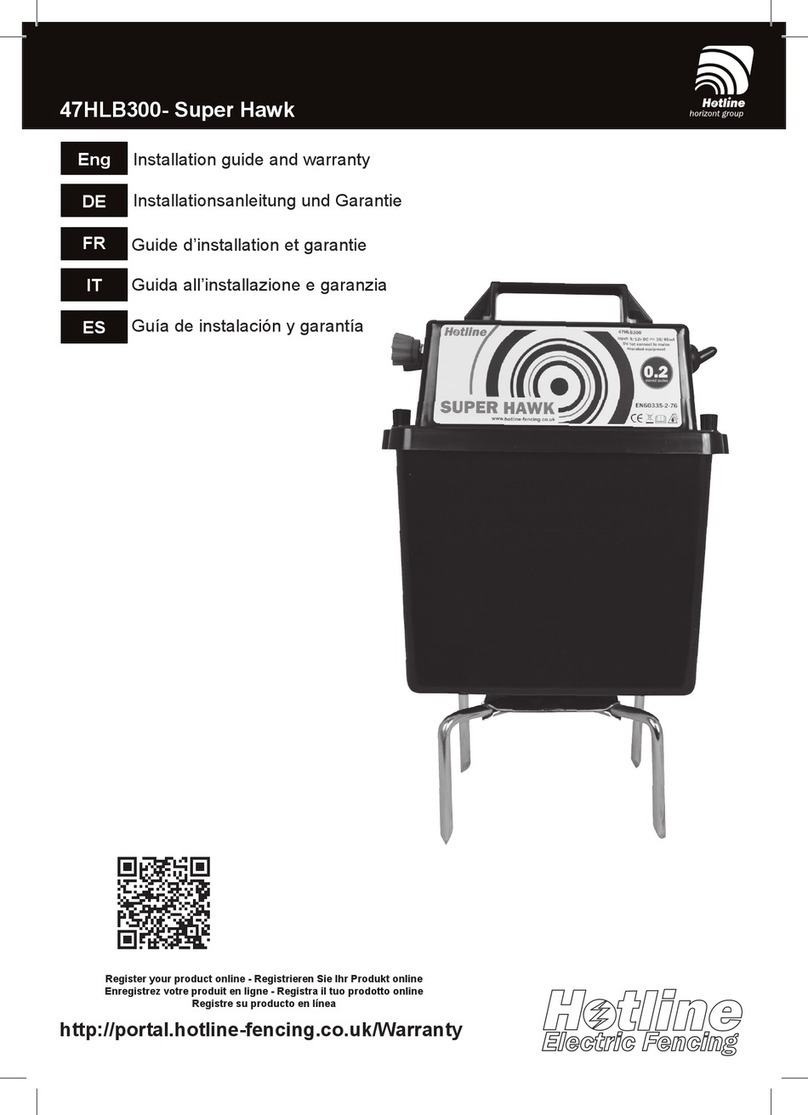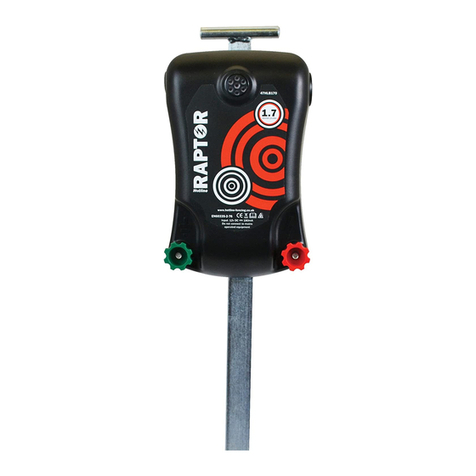
Fehlersuche
Um die Effektivität sicherzustellen, sollten Sie eine Spannung von mindestens 3 kV an Ihrem Zaun anliegen
haben. Das Konzept von Elektrozäunen ist grundsätzlich recht einfach. Wenn Ihr Elektrozaungerät funktioniert,
gibt es nur zwei andere Stellen, die Sie überprüfen können - Ihre Zaunleitung oder das Erdungssystem.
Sehen und Hören - Bei den meisten Elektrozaungeräte ist ein rhythmisches Ticken wahrnehmbar, das
durch die Zündung des Ausgangstransformators verursacht wird. Dies ist ein gutes Zeichen dafür, dass das
Elektrozaungerät ordnungsgemäß funktioniert. Die Anzeigenleuchte bzw. der Zaunmonitor sollte aufackern
oder blinken. Das Elektrozaungerät verfügt über eine Impuls-Anzeige und diese sollte immer in Betrieb
sein. Wenn die Leuchte grün blinkt, bedeutet dies gewöhnlich, dass das Elektrozaungerät ordnungsgemäß
funktioniert. Dies weist auf ein Problem innerhalb der Zaunanlage hin. Blinkt die Leuchte rot, muss die
Batterie aufgeladen werden. Flash-Test - Trennen Sie die Sicherheits-Abgreifklemmen vom Zaun und vom
Staberder. Klemmen Sie die Sicherheits-Abgreifklemmen zusammen und stellen Sie sicher, dass sich die
Metallbacken berühren. Ziehen Sie sie langsam auseinander - es sollte ein kleiner (1-2 mm) Funke von
einem Anschluss zum anderen überspringen. Testgerät verwenden - Vollständig vom Staberder und Zaun
trennen und eine Ablesung an den Anschlüssen vornehmen. Je nach Modell des Elektrozaungeräts sollte
ein Messwert zwischen 7 und 10 kV abgelesen werden.
Niedrige Spannung - Falls am Staberder eine hohe Spannung anliegt, fehlt diese an der Zaunleitung. Je
größer die Tiefe und Fläche unter der Erde, desto efzienter wird der Staberder den Impuls erfassen, wenn
dieser durch die Erde zurückießt. Wenn Sie am Staberder einen Stromschlag bekommen oder Ihr Testgerät
eine Spannung anzeigt, wenn Sie es an den Staberder halten, können Sie Ihr gesamtes System verbessern,
indem Sie weitere Staberder installieren. Verbinden Sie die zusätzlichen Staberder mit Draht und stellen Sie
sie in einem Abstand von einem Meter zueinander auf.
Saubere Leitungen - Ein Elektrozaun ist als offener Stromkreis konzipiert. Der Zaun ist positiv und der
Erdboden an sich ist negativ. Wenn ein Tier nun sowohl den Zaun als auch den Erdboden berührt, schließt
es den Stromkreis und bekommt einen Stromschlag. Berührt ein anderes Objekt als ein Tier sowohl den
Erdboden als auch den Zaun, reduziert sich die effektive Spannung der Zaunleitung. Die Zaunleitung
darf mit keinem Objekt in Berührung kommen, das nicht vom Erdboden aus isoliert ist. Prüfen Sie, ob
die Zuleitung von Bewuchs befreit ist, und dass keine Holzpfosten, Metallpfosten oder Tore die Leitung
berühren. Kontrollieren Sie alle Isolatoren. Die Zaunleitung kann sich gelegentlich von den Isolatoren lösen
und die Pfosten berühren und defekte Isolatoren können zu einem Austritt des Stromes in die Pfosten und
den Erdboden führen. Leitungsprobleme - Wenn Sie zwei Klebeband- oder Drahtabschnitte miteinander
verbinden, verwenden Sie bitte die korrekten Verbindungen, um sicherzustellen, dass die Leiter in beiden
Abschnitten miteinander verbunden sind. Kontrollieren Sie den Zustand der Leitung - wenn die Metallleiter in
der Leitung defekt sind, wirkt sich dies auf den Wirkungsgrad des Zauns aus. Ein größerer Metallgehalt erhöht
den Wirkungsgrad. Maschendrahtzaun - Ein Maschendrahtzaun ist näher am Erdboden als jede andere
Art von Zaun und ist daher wartungsintensiver hinsichtlich der Beseitigung von Bewuchs. Alle horizontalen
Leitungen, außer vom Boden, müssen vom Erdboden her freigehalten werden. Wenn Ihr Maschendrahtzaun
durchhängt und den Erdboden berührt, stellen Sie weitere Pfosten auf. Der Maschendrahtzaun darf zudem
auch nicht mit anderen Zäunen, mobilen Hühnerställen oder den Maschendrahtzäunen von Hühnerhöfen
in Berührung kommen. Kontrollieren Sie die Metallspitzen an den Pfosten - gelegentlich kann der Draht
an den Metallspitzen hängenbleiben oder herunterrutschen und somit Strom zum Erdboden leiten. Bitte
beachten - Wenn Ihr Elektrozaungerät und Erdungssystem problemlos funktionieren, wird der Fehler bei
Ihrer Zaunleitung zu nden sein!
Im Zweifelsfall, rufen Sie uns an - Wir helfen Ihnen gerne. +44 (0) 1626 33 11 88
Überprüfung des Elektrozaungeräts
Überprüfung des Erdungssystems
Überprüfung der Zaunleitung
DE.indd 4 18/02/2019 11:10:13






























